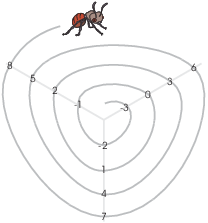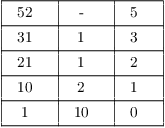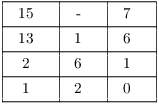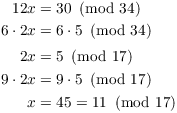Modular arithmetic is a way of systematically ignoring differences involving a multiple of an integer. If n is an integer, two integers are equal mod n if they differ by a multiple of n; it is as if multiples of n are "set equal to 0".
Definition. Let n, x, and y be integers. x is
congruent to y mod n if
![]() . Notation:
. Notation:
![]()
Remarks. ![]() is equivalent
to the following statements:
is equivalent
to the following statements:
(a) ![]() .
.
(b) ![]() for some
for some ![]() .
.
(c) ![]() for some
for some ![]() .
.
I'll often use any of these four statements as the definition of ![]() .
.
A lot of people like to write "![]() " instead of "
" instead of "![]() ". I don't think there's any harm in
using an ordinary equal sign, since the "
". I don't think there's any harm in
using an ordinary equal sign, since the "![]() " makes the meaning clear. It's also a bit
shorter to write.
" makes the meaning clear. It's also a bit
shorter to write.
Example. ( Examples of
congruences with numbers) (a) Demonstrate that ![]() and
and ![]() .
.
(b) Express "x is even" and "x is odd" in terms of congruences.
(c) What does ![]() means in terms of
divisibility?
means in terms of
divisibility?
(a)
![]()
![]()
(b) x is even if and only if ![]() and x is
odd if and only if
and x is
odd if and only if ![]() .
.![]()
(c) ![]() if and only if
if and only if ![]() . Thus, congruences provide a convenient notation for
dealing with divisibility relations.
. Thus, congruences provide a convenient notation for
dealing with divisibility relations.![]()
The following proposition says that you can work with modular equations in many of the ways that you work with ordinary equations.
Proposition. Let ![]() .
.
(a) If ![]() and
and ![]() , then
, then
![]()
(b) If ![]() and
and ![]() , then
, then
![]()
(c) If ![]() , then
, then
![]()
Proof. Two ideas for these kinds of proofs:
1. You can often prove statements about congruences by reducing them to statements about divisibility.
2. You can often prove statements about divisibility by reducing them to (ordinary) equations.
(a) Suppose ![]() and
and ![]() .
.
![]() means
means ![]() and
and ![]() means
means ![]() . By
properties of divisibility,
. By
properties of divisibility,
![]()
Therefore, ![]() .
.
(b) Suppose ![]() and
and ![]() .
.
![]() means
means ![]() , which means
, which means
![]() for some
for some ![]() .
. ![]() means
means ![]() , which means
, which means ![]() for some
for some ![]() . Thus,
. Thus, ![]() ,
, ![]() , and hence
, and hence
![]()
This gives ![]() , so
, so ![]() , and hence
, and hence ![]() .
.
(c) Suppose ![]() . This means that
. This means that ![]() . By properties of divisibility,
. By properties of divisibility,
![]()
Therefore, ![]() .
.![]()
Example. ( Solving a
congruence) Solve ![]() .
.
In this case, I'll solve the modular equation by adding or subtracting the same thing from both sides.

The solution is ![]() .
.![]()
Example. Reduce ![]() to a number in the
range
to a number in the
range ![]() , doing the
computation by hand.
, doing the
computation by hand.
Note that
![]()
So
![]()
The next result says that congruence mod n is an equivalence relation.
Proposition.
(a) (Reflexivity) ![]() for all
for all ![]() .
.
(b) (Symmetry) Let ![]() . If
. If ![]() , then
, then ![]() .
.
(c) (Transitivity) Let ![]() . If
. If ![]() and
and ![]() , then
, then ![]() .
.
Proof. (a) If ![]() , then
, then ![]() , so
, so ![]() .
.
(b) If ![]() , then
, then ![]() , so
, so ![]() .
Therefore,
.
Therefore, ![]() .
.
(c) Suppose ![]() and
and ![]() .
. ![]() means
means ![]() ;
; ![]() means
means ![]() . Therefore,
. Therefore,
![]()
Hence, ![]() .
.![]()
An equivalence relation on a set gives rise to a partition of the set into equivalence classes. In the case of congruence mod n, an equivalence class consists of integers congruent to each other mod n.
Definition. ![]() (read "Z mod n") is the set of equivalence
classes under congruence mod n.
(read "Z mod n") is the set of equivalence
classes under congruence mod n.
Example. ( Congruence classes mod 3) Find the equivalence classes of the relation congruence mod 3 on the set of integers.
Relative to the equivalence relation of congruence mod 3 on ![]() , the integers break up into three disjoint
sets:
, the integers break up into three disjoint
sets:

All the elements of a given set are congruent mod 3, and no element in one set is congruent mod 3 to an element of another. The sets divide up the integers like three puzzle pieces.
It's cumbersome to write and use equivalence classes as is, since each equivalence class is a set (infinite, in this case). It's customary to choose a representative from each equivalence class and use the representatives to do arithmetic. I'll choose
![]()
![]()
![]()
I'll abuse notation and write
![]()
![]() is called the cyclic
group of order 3. The "cyclic" nature of
is called the cyclic
group of order 3. The "cyclic" nature of ![]() can be visualized by arranging the integers in a
spiral, with each congruence class on a ray.
can be visualized by arranging the integers in a
spiral, with each congruence class on a ray.

When you do arithmetic in ![]() , it is as if
you count in a circle: 0, 1, 2, then back to 0 again.
, it is as if
you count in a circle: 0, 1, 2, then back to 0 again.
You can form other cyclic groups in an analogous way. For example,
![]()
You can do arithmetic in ![]() by adding and
multiplying as usual, but reducing the results mod
n.
by adding and
multiplying as usual, but reducing the results mod
n.
Example. ( Operation tables
for ![]() ) Construct addition and
multiplication tables for
) Construct addition and
multiplication tables for ![]() .
.

For example, as integers ![]() . I divide 4 by the
modulus 3 and get a remainder of 1. Hence,
. I divide 4 by the
modulus 3 and get a remainder of 1. Hence, ![]() .
.
Likewise, ![]() in
in ![]() .
.![]()
Example. ( Equations in
![]() ) Find
) Find ![]() in
in ![]() ,
, ![]() in
in ![]() , and -8 in
, and -8 in ![]() .
.
![]()
![]()
![]()
-8 means the additive inverse of 8. The last statement is just
another way of saying ![]() .
.![]()
Example. ( Using modular
arithmetic in a divisibility proof) Prove that if n is an
integer, then ![]() is not divisible by 5.
is not divisible by 5.
Every integer n is congruent to one of 0, 1, 2, 3, or 4 mod 5.
Therefore, I have 5 cases. In each case, I want to show that ![]() is not divisible by 5 --- or to say it in
terms of congruences, I want to show that
is not divisible by 5 --- or to say it in
terms of congruences, I want to show that ![]() .
.
I set ![]() and
"substitute" the value into
and
"substitute" the value into ![]() . This substitution is justified by the
properties of congruences I discussed above.
. This substitution is justified by the
properties of congruences I discussed above.
For example, if ![]() , then
, then

Likewise, ![]() . So
. So
![]()
Essentially, I can plug ![]() into
into ![]() , then reduce the result mod 5 to one of 0,
1, 2, 3, or 4.
, then reduce the result mod 5 to one of 0,
1, 2, 3, or 4.
Continuing in this way, I get the following table:

In all five cases, ![]() .
Therefore,
.
Therefore, ![]() is never divisible by 5.
is never divisible by 5.![]()
I showed earlier how to use algebraic operations to solve simple modular equations. How would you solve something like this:
![]()
I'd like to divide both sides by 6, but I only know how to add and multiply. I can subtract, but that's because I can add additive inverses. Well, division is multiplication by the multiplicative inverse; what is a multiplicative inverse mod 25?
Definition. Let ![]() . a and b are
multiplicative inverses if
. a and b are
multiplicative inverses if ![]() (or
(or ![]() in
in ![]() ).
).
If a is the multiplicative inverse of b, you can write ![]() .
.
(You don't write "![]() " unless
you're in a number system like the rational numbers where fractions
are in use.)
" unless
you're in a number system like the rational numbers where fractions
are in use.)
Example. ( Modular multiplicative inverses) (a) Prove that 6 and 2 are multiplicative inverses mod 11.
(b) Show that 8 does not have a multiplicative inverse mod 12.
(a) ![]() .
.![]()
(b) One tedious way is to take cases:

No number multiplied by 8 gives 1 mod 12.
I could try all the possibilities because the numbers were small. How would you do this kind of problem if the numbers were larger?
One approach is to simply appeal to the result following this example. However, I can also give a proof by contradiction.
Suppose that 8 has a multiplicative inverse mod 12. Let x be the
multiplicative inverse. Then ![]() .
Multiplying both sides by 3, I get
.
Multiplying both sides by 3, I get
![]()
This is a contradiction, since 0 and 3 do not differ by a multiple of
12. Therefore, 8 does not have a multiplicative inverse mod 12.![]()
Proposition. ![]() has a multiplicative inverse if and only if
has a multiplicative inverse if and only if
![]() .
.
Proof. Suppose ![]() has a multiplicative inverse, so
has a multiplicative inverse, so
![]()
I can regard this as a statement in ![]() :
:
![]()
This means that ![]() and 1 differ by a
multiple of n:
and 1 differ by a
multiple of n:
![]()
Thus,
![]()
This is a linear combination of m and n which gives 1. Therefore,
![]() .
.
Conversely, suppose ![]() . I may find integers a and
b such that
. I may find integers a and
b such that
![]()
That is,
![]()
Now regarded as an equation in ![]() , this says
, this says
![]()
That is, m has multiplicative inverse a.![]()
Example. ( Using the Extended
Euclidean algorithm to find modular inverses) Find the
multiplicative inverse of 31 in ![]() .
.
Note that ![]() . Apply the Extended Euclidean
Algorithm:
. Apply the Extended Euclidean
Algorithm:

Thus,
![]()
In ![]() ,
, ![]() and
and ![]() . The equation says
. The equation says ![]() . Thus, 47 is the multiplicative inverse of
31 in
. Thus, 47 is the multiplicative inverse of
31 in ![]() .
.![]()
Theorem. If ![]() , then the following equation has a unique solution:
, then the following equation has a unique solution:
![]()
Proof. If ![]() , then a has a
multiplicative inverse
, then a has a
multiplicative inverse ![]() in
in ![]() . Thus,
. Thus, ![]() in
in ![]() .
.
First, this means that ![]() is a solution, since
is a solution, since
![]()
Second, if ![]() is another solution, then
is another solution, then ![]() . Multiplying both sides by
. Multiplying both sides by ![]() , I get
, I get
![]()
That is, ![]() . This means the solution is unique.
. This means the solution is unique.![]()
Example. ( Solving modular equations using modular inverses) Solve
![]()
There is a solution, since ![]() . I need to
find a multiplicative inverse for 13 mod 15.
. I need to
find a multiplicative inverse for 13 mod 15.

The Extended Euclidean Algorithm says that
![]()
Hence, ![]() , i.e. 7 is the
multiplicative inverse of 13 mod 15.
, i.e. 7 is the
multiplicative inverse of 13 mod 15.
Multiply the original equation by 7:
![]()
Proposition. Suppose
![]()
Then
![]()
Proof. I have

(Note that ![]() and
and ![]() , so
, so ![]() and
and ![]() are actually integers.) Now
are actually integers.) Now ![]() divides
divides ![]() , but
, but
![]()
By Euclid's lemma, ![]() . Hence,
. Hence,
![]()
I can use the preceding result to solve some congruences when I can't immediately use modular inversion.
Example. Solve
![]()
Since ![]() , 12 doesn't have a
multiplicative inverse mod 34. I'll use the preceding result. I
"cancel" a factor of 6 from
, 12 doesn't have a
multiplicative inverse mod 34. I'll use the preceding result. I
"cancel" a factor of 6 from ![]() and 30, and divide the modulus 34 by
and 30, and divide the modulus 34 by ![]() :
:

Since the original congruence was mod 34, I must find all numbers in
![]() which satisfy
which satisfy ![]() . One is obviously 11. Adding 17, I find
that
. One is obviously 11. Adding 17, I find
that ![]() also works. (Adding 17 again takes
me out of the set
also works. (Adding 17 again takes
me out of the set ![]() .)
.)
The solutions are ![]() and
and ![]() .
.![]()
Copyright 2018 by Bruce Ikenaga